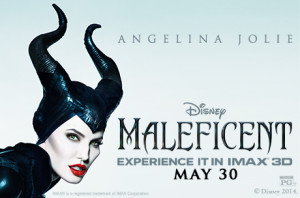Although he’s making his directing debut with “Maleficent,” Robert Stromberg knows full well how to best employ 3D and exploit the larger IMAX film frame (Oscar-winner for art direction on “Avatar” and Tim Burton’s “Alice in Wonderland”).
And he and “Maleficent” writer Linda Woolverton sure know about Disney films (Woolverton is also an Oscar nominee and Golden Globe winner for “Beauty and the Beast” and wrote “The Lion King”).
And they both know how to adapt Disney animated classics as re-imagined live-action stories (they collaborated on “Alice in Wonderland” and Woolverton has written the 2016 release “Through the Looking Glass”). 
No wonder “Maleficent” comes across as good solid entertainment that is noticeably enhanced in IMAX and especially in 3D. The 3D is impactful throughout but especially in periodic scenes including Maleficent flying over her side of the river (who knew she was a fairie with wings?), sweeping aerial shots around the castly, scenes of brightly-colored sprites hovering in the woods (who knew Maleficent lived on the other side of the river with a menagerie of magical beings called moors?), in many scenes involving the familiar blue, red, and green fairies, and in the many shots of the raven and dragon dispatched by Maleficent (who knew those were both a guy who keeps changing form at the whim of Maleficent?).
The size and image quality of IMAX provides such size and vivid clarity that we even notice scenes in which Maleficent’s fingernails are white with red on the underside.
The fun in re-creating this tale begins right from the opening moment when the familiar Disney logo that is the Sleeping Beauty castle from Disneyland spins to show a larger side and backside.
Most of this story is an original backstory that explains that Maleficent’s evil personality was rooted in being jilted by an egotistical young human man (not really sure how a human and fairy with huge wings would have hooked up short-term or long-term anyway). Does this mean there are new revisionist-history movies coming from Disney in which we see that Cruella de Ville was abused as child and that Ursula the Sea Witch could never measure up to the demanding expectations of her octupus father?
We learn in this tale that Maleficent was raised in a Hatfield and McCoys-type ongoing feud between the kingdom of humans in which Princess Aurora was born and the moors on the other side of the river. In keeping with Disney fairy tale tradition, Maleficent has no parents, of course, nor apparently anyone else of her species — even the fairies-turned-nannies for the baby Aurora are much smaller and less powerful. But the trio are given many of the film’s scenes of homage to the 1959 classic, including bumbling the house-cleaning duties and splattering each other with colored paint.
<Review continues below the following trailer…>
Stromberg also offers nice visual salutes to the Salvador Dali-inspired art design of the original, from Angelina Jolie’s jet black Maleficent costume to the bleak black wall of thorns surrounding the castle (which also project as more imposing in 3D), and even the dragon itself.
Maleficent seems to be able to conjure up almost any type of magic, including making others levitate or change into animals or humans, yet she is unable to repair her own flying ability and she is given a Superman-like demobilizing kryptonite-type substance — she nearly faints at the touch of iron ( handy, since iron was in great supply in the days of the knights of armor). But here the character has a far deeper storyline, one that is so completely transformed into being sympathetic that you will be surprised to see her newly-defined relationship with the Princess on whom she cast the notorious sleeping spell, along with a sigificant twist for the story’s climax.
Given all these story and character revisions, “Maleficent” is ultimately perhaps more interesting than fully entertaining. And one is engaged enough that the lack of any songs typical of the Disney animated classics is not really noticeable, though it would have helped to at least have had one song that sticks with you as “Once Upon a Dream” still does, or even as does the haunting choral elements of “Alice’s Theme” from Burton’s “Alice in Wonderland.”
— By Scott Hettrick
